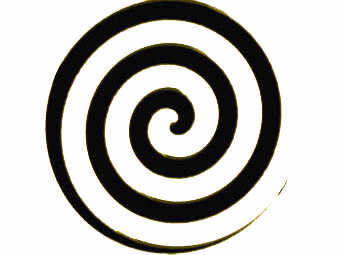Thursday, July 30, 2009
Eagles playing ... 'Chicken'?
National Geographic shows how eagles claim their territory. Known as 'whirling', the eagles grab each others talons and plummet into free fall. Daring one another to let go first - whoever does is the loser.
Tuesday, July 28, 2009
Sunday, July 26, 2009
Glowing in the Dark

Everyone has seen glow sticks or glow-in-the-dark stickers and posters or even lightning bugs. But did you know there are more than 50 species of plants and animals that glow?
Various jellyfish exhibit a phenomenon known as 'bioluminescence' - essentially glowing in various colors - as a means of defense. Plankton known as dinoflagelletes will emit light when threatened in order to attract larger predators that will eat the dinoflagelletes predator. Bioluminescence also occurs in railroad worms, pinecone fish, ping pong trees, and octopus. In bioluminescence, chemical energy is converted to light energy through an enzyme-catalyzed chemoluminescence reaction'. This means luciferase oxidizes the 'pigment luciferin (oxidation is the same process that is responsible for the rusting of metals through the loss of one or more electrons). Here's another video of various animals that glow through the process of bioluminescence.
Others, such as comb jellyfish, produce a rainbow through a different process of scattering light across it's moving 'combs' (cilia, or tails, which help in locomotion).
Amongst animals, the phenomenon is believed to 1) help frighten off predators when the animal feels threatened, 2) to camouflage the animal by blending with the surrounding levels of light, 3) or even to attract prey or a mate.
Plant life such as mushrooms and fungus are believed to have this quality to help attract pollinators.
Wednesday, July 22, 2009
Pure Speed

Registering speeds over 270 mph, the peregrine falcon is nearly five times faster than a cheetah - the fastest animal on land. No living creature on the earth can compare when it comes to speed ... or maneuverability.
When a peregrine falcon attacks, it assumes a 'lock and load' stance and plunges. It can either kill it's prey with a sharp blow with its claws, or paralyze it by striking the neck of the prey with it's powerful beak. Aside from a membrane which covers its eyes (much like a shark) during a dive to avoid dust scratching its eyes, the peregrine falcon can rotate on its own axis and ultimately experience up to 25 g-forces. This means that the peregrine falcon can withstand a force 25 times the force of gravity. In other words, if you weighed 100 pounds, your body would weigh 2,500 pounds when pulling out of a dive like this. If any human tried to do that, every bone in their body would shatter. The peregrine falcon is able to withstand such forces because its bones flex and move with the force (much like bamboo does) instead of assuming a rigid stance (like wood).
If you've seen its attack, you may be reminded of many of today's fighter jets. In fact, air forces have developed jets with wings that fold in a manner similar to the peregrine falcon.
Tuesday, July 21, 2009
Fly Swatting 101

I'm sure you've seen President Obama's impressive fly swatting incident during a CNBC interview.
But why is it so hard to swat a fly?
Believe it or not, scientists have done studies on this question. Apparently, to avoid being swatted, flies place their weight on their middle legs while seated and, sensing an attack shuffle their feat and position themselves to fly off in the opposite direction ... within 200 milliseconds. Flies also possess cilia - special hairs designed to detect even the slightest changes in air pressure.
Aside from the quickness with which the fly reacts, the reaction itself is baffling as a fly, despite its minuscule brain, can process an oncoming attack with astounding speed.
So what can you do to make sure you outsmart a fly? Do what President Obama did - anticipate which way it will fly off and come in from that angle.
Cooking with the Sun

CNN reports a novel method of cooking cheap enough that it can be readily used in the 3rd world, and will simultaneously help clean the environment.
Jon Bøhmer's 'Kyoto Box' is made of cardboard, a black interior, aluminum foil-covered top panels, and a plexiglass cover, trapping sunlight to cook, bake, clean water and dry food. The box avoids smoke inhalation, fire hazards, and time loss due to the gathering of firewood. It also helps in the fight against carbon emissions, rising energy costs, and deforestation.
So how much of a background in science does one need to help discover the next big green solution? Not much if you have Bøhmer's luck, "This took me about a weekend, and it worked on the first try. It's mind-boggling how simple it is."
Sunday, July 19, 2009
Density and Sound
Ever wonder why your voice sounds lighter when inhaling helium? It is because sound waves speed is dependent upon the medium through which it is moving.
Through 'air' at sea level, sound moves at ~770 mph. When you change the density of the medium, the sound wave will most faster or slower.
Helium is ~6 times less dense than air; i.e. sound will move 6 times faster through it, translating to a higher pitch.
In contrast, something like sulfur hexafluoride is ~6 times denser than air and the exact opposite effect will happen.
See for yourself.
Through 'air' at sea level, sound moves at ~770 mph. When you change the density of the medium, the sound wave will most faster or slower.
Helium is ~6 times less dense than air; i.e. sound will move 6 times faster through it, translating to a higher pitch.
In contrast, something like sulfur hexafluoride is ~6 times denser than air and the exact opposite effect will happen.
See for yourself.
Zombies in Nature - seriously

It's true: nature gives us example after example of insects and animals which have essentially become zombies - whose central nervous system has been taken over by any number of parasites.
These videos of snails, bullet ants, aphids, caterpillars, cockroaches - among other creatures - all show that parasites completely overrun the host creatures brain to create a perfect living environment, even making the host creature (which it is slowly killing) defend the parasite from external threats!
While this is shocking, the phenomenon does not stop with lower life forms ... even humans are believed to be susceptible to parasitic take over. Through a parasite known as toxoplasma gondii (commonly found in cat waste), humans are believed to suffer from schizophrenia.
Friday, July 17, 2009
Oil Companies Going Green?

Biofuel is the next big thing. The problem is that today's biofuels (ethanol, soybean biodiesel) come with many socio-economic externalities, or harmful side effects.
With fossil fuel consumption having largely contributed to global warming, and biofuel consumption having similar bad side effects, can mankind ever go green? YES.
Teaming up with the likes of Craig Venter, ExxonMobil, among others, has invested extensively into biofuel development - using algae.
Algae, unlike other currently existing biofuels, does not occupy arable land, is extremely cheap, readily available, and consumes carbon dioxide in the process.
To understand the process, check out this short clip.
Labels:
algae,
Biology,
biotechnology,
Clean Energy,
environmental issues
Thursday, July 16, 2009
We can be invisible??!!

Yes - and soon, according to Natural History Magazine. But how?
First understand that light is one of many types of 'waves' (essentially bundles of mobile energy). Light is the one wave which, by bouncing off objects, makes objects visible to humans.
Light, as we know, travels at an incredible speed (186,000 mps). When it travels through different mediums, particularly those denser then air (e.g. water), it slows down. The slowing down of light is observed by it bending - a phenomenon known as 'refraction'. Anyways, the more dense the material, the more light slows down, and, consequently, bends.
Through the use of specially engineered 'metamaterials', scientists at Duke University have been able to bend light beyond what was considered possible (see video). As of now, they have created objects which become completely invisible, save for the casting of a small shadow.
With ongoing research in the field, maybe one day we'll be able to get a cloak like Harry Potter!
Tuesday, July 14, 2009
High Wire Walking

I thought this was amazing ... and crazy.
If you haven't seen Academy Award Winning Man on Wire, it's a documentary featuring Philippe Petit's mind bending 45 minute walk between the World Trade Center Towers in 1974.
High wire walkers, including Pettit, hold a pole in their hand to take advantage of inertia (resistance to change in motion). The pole gives the tightrope walker a larger moment of inertia - meaning their angular motion will be less susceptible to change because the pole offsets any force the wire exerts on the walker - meaning they have less a chance of falling.
So, now that you know why high wire walkers hold a pole, watch Man on Wire ...
Then, watch this
Philosophy and Neuroscience
Discover Magazine has summarized a study arguing that wisdom has a neurological component. Generally considered within the confines of philosophy, researchers pinpointed areas of the brain which, coupled with emotion and instinct, operate in a manner associated with wisdom.
In related news, watch this short video regarding the study of Einstein's brain.
Monday, July 13, 2009
What is Happiness?
Sunday, July 12, 2009
Hope for Lost Limbs

Salamanders have the amazing ability to regenerate a lost limb. Regeneration was assumed to occur because wound site cells would revert to 'pluripotent stem cell' status — allowing them to develop into many cell types and recreate the lost appendage — something adult human cells cannot do.
Nature recently published a study noting that salamanders' cells retain cell memory - that is they do not regrow from scratch. Rather than re-engineering human cells, it seems that the challenge is of coordinating already existing cells (like the salamander does) to reboot and regenerate. While a lot of work remains, the researchers now believe human limb regeneration may be an easier task than previously thought.
Saturday, July 11, 2009
A Wandering Mind
We all zone out, oftentimes at alarming rates. Discover Magazine recently ran an interesting article arguing that zoning out may not necessarily be a bad thing. Noting that most of the thoughts during zoning out deal with the future and much of deep thought occurs during these periods, Carl Zimmer posits that zoning out allows us to reach goals, but separates them based on their immediacy.
In related news, the Atlantic Monthly ran a feature article some time back entitled "Is Google Making Us Stupid?". Nicholas Carr argues that technological advancements have had a profound impact on how we think. Prior to the typewriter, we had much longer, drawn out sentences, but afterwords writing became much more terse. Today, the age of the internet and hypertext, has redefined 'short attention span' - think blog.
Subscribe to:
Posts (Atom)




